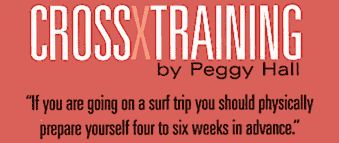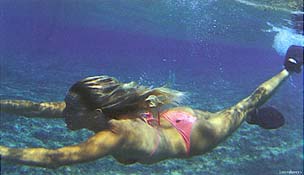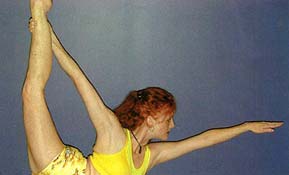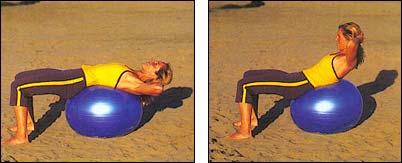SURF LIFE FOR WOMEN MAGAZINE, Fall 2003, page 28
Photo: Dan JenkinsAs surfers, we thrive on the energy of the ocean. When we can't get in the water, we grow restless and start to wonder what kind of shape we'll be in the next time we surf.
Luckily, we can keep from going crazy by "cross training" -- engaging in other activities that complement our surfing. From yoga to swimming to weight training, there is something we can do to make sure we're as fit as possible the next time we paddle out. "Cross training will develop seldom-used muscles and will create a more balanced body," explains Paul Friedani, author of Surf Flex. "This will help avoid overuse of specific muscle groups while promoting good health, balance, and performance. If you are going on a surf trip you should physically prepare yourself four to six weeks in advance."
Here are a few cross training ideas, from conventional to cutting-edge, to get you started. Incorporate any (or all) of these awesome activities and see what works best for you.
Photo: Lane DaveySWIMMING
Even if there's no swell, you can still get in the ocean for some open-water training! (A lap pool will also do.) Swimming uses many of the same muscles as surfing, so you'll be working your shoulders, upper back, chest, torso, and legs -- all while increasing your cardiovascular endurance. Swimming is an excellent full-body, low-impact workout with the added benefit of making you more comfortable in the water. When you know you can swim your way back to the beach, you'll be more willing to take those late drops on the big sets!Ocean swimming should be done with a partner and takes some training to get used to the currents. Make sure you find a good teacher! Lap swimming can be done at just about any recreational pool and many places offer a Masters Swimming program that allows you to train with a coach and others for a more competitive workout.
Bonus: swimming increases your confidence in the water. Caution: swim on days you're not surfing to avoid overworking your shoulders. For more info on incorporating swimming into your surf training, check out www.swimzone.net or pick up "Total Immersion" (www.totalimmersion.net) by renowned coach Terry Laughlin. For Masters Swimming check out www.usms.org
RESISTANCE TRAINING
Also known as weight or strength training, resistance training can be performed with dumbbells, barbells, machines, cables, resistance bands, or even your own body weight. With resistance training, you'll stimulate muscle growth, but you don't have to worry about turning into Arnold Schwarzenegger -- we gals don't possess enough testosterone to bulk up that much. (In fact, many professional female bodybuilders have to turn to steroids to grow their huge muscles.)
Photo: Gigi ColvinA standard guideline for resistance training is to choose a weight that allows you to do 12-15 repetitions of each exercise. Try doing a "circuit" on cable machines or resistance bands where you move through several exercises (doing 12-15 reps each) without stopping. Then rest two minutes and repeat the entire circuit three times. Focus on the back of shoulders, rotator cuff muscles, upper back, lats, chest, and biceps. Include pull-ups or chin-ups in your routine to improve your paddling and don't forget your legs. Two or three times a week is sufficient for building strength, power, and muscle endurance. "Like most explosive sports, surfing is a circuit-like event (start-stop-start-stop)," explains Mark McElroy, creator of the Surf Fitness program. "So it only makes sense to pick exercises that work your energy systems the same way. Circuit training is by far the most superior form of endurance training for surfing. Remember to use exercises that look and feel like surfing during your circuits."
Bonus: strength training will tighten and tone your physique and increase metabolism. Caution: start out with a personal trainer to learn safe execution of the exercises. For more info on strength training, check out www.surfflex.com or www.surffitness.com for surf specific training. For more gym oriented training check out www.muscleandfitnesshers.com
YOGA
Top pros including Rochelle Ballard, Layne Beachley, Taylor Knox, and Kelly Slater have all used yoga to stay loose, flexible, and focused in the surf. Yoga is one of the best activities surfers can do because it actually restores energy by nourishing and revitalizing every cell of the body! Practicing yoga helps build flexible strength, endurance, balance, and mental focus -- all necessary for fluid, powerful surfing. Yoga breathing or "pranayama" increases lung capacity so you can stay calm and relaxed even in a wipeout.
Photo: Susan FlintThere are many varieties of yoga and different styles of teaching, so be sure to shop around until you find a good fit. Let your instructor know that you're a surfer and ask for specific poses that will open the shoulders, stretch the hips, and keep the back strong and flexible. "There are some very good restorative yoga poses like child's pose and supported chest openers that make recovery a lot more productive," says Kurt Dabisch, a personal trainer at Equinox Fitness Club in New York City "Even the active yoga poses like sun salutations and doing downward dog to upward dog have a great effect on recovery. Besides helping get the lactic acid out of the muscles, yoga poses result in your feeling better than when you started."
Bonus: yoga increases your sense of well-being and inner strength. Caution: avoid forcing yourself into unfamiliar or advanced poses. Move at your own pace and listen to your body For more info on surf-specific yoga, check out the Yoga for Surfers Instructional Video Series, www.yogaforsurfers.com. For general cross training yoga check out www.y4a.com.
A Swiss Ball can be used for everything from stretching to balance exercises to core strengthening
Photo: Gigi ColvinPILATES
Long used as a training method by dancers and gymnasts, Pilates has made it into the mainstream -- and for good reason. A Pilates workout will trim your tummy, perfect your posture, and firm your fanny with just a few precision-like repetitions of each exercise. Performed on the floor, Pilates exercises are extremely effective in lengthening and strengthening the deep core muscles of the body; These stabilizing muscles hug and protect our bones, improving balance and preventing injury -- both essential for healthy surfing.Drop into one of the many Pilates classes offered at gyms and yoga studios, or practice at home with a video. "The Method" series by Jennifer Kreis is the absolute best!
Bonus: Pilates helps you look taller and move more gracefully. Caution: support your head and neck in all exercises to avoid strain. For more info about Pilates check out www.pilates-video.com or www.bodymind.net
PLYOMETRICS
At the other end of the spectrum from yoga and Pilates is plyometrics, a training system based on explosive, powerful moves. Since plyometrics can be demanding on the joints, muscles, and ligaments, it is suited for those in good shape who want to take their fitness to the next level. An example of a plyometric move is the power pushup: lower yourself into a traditional pushup, then push off the ground forcefully, clap your hands, and then catch yourself as you lower again. Whew! Plyometrics include an infinite number of unique exercises that condition every muscle of the body. You'll work up a sweat, increase your strength and power through turns like never before! You may want to work with a personal trainer for a few sessions to learn the moves before training on your own.Bonus: plyometrics helps you develop explosive power and lightning-quick reflexes. Caution: only for those looking for high intensity. For more info about plyometrics, check out: www.performbetter.com or www.sport-fitness-advisor.com
TRAINING GUIDELINES
Learn as much as possible about the activity. Check websites and browse the bookstores for information. Hire a personal trainer for a couple of sessions until you feel confident to train on your own.Vary your activities. Even a steady regime of yoga can stress the body if there's not enough variety. Aim for two or three different activities each week.
Be patient as you're challenging your body and mind. Remember to move mindfully to get the most out of your workout.
Rest at least one day a week to give your body a chance to recover. Strength actually builds when we're resting, not while we're exercising.
Enjoy your new-found strength, flexibility, and power. See you in the lineup!






